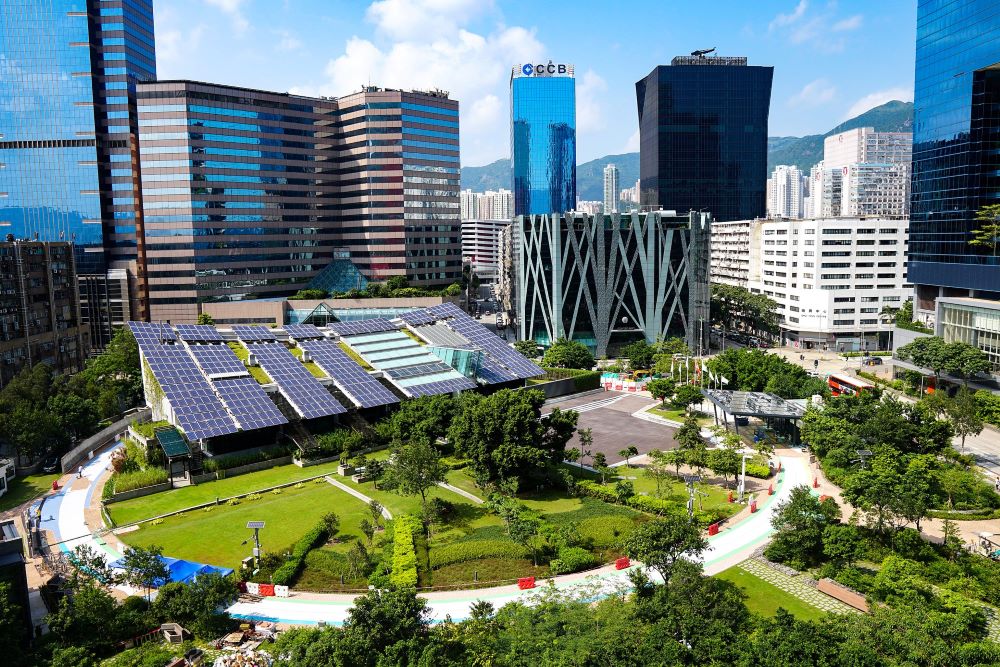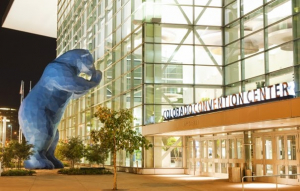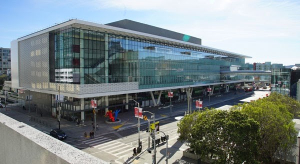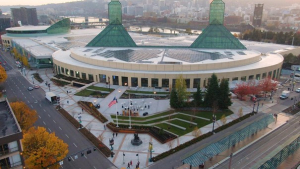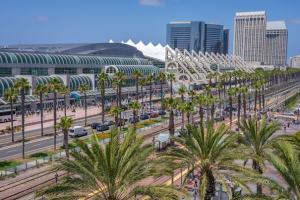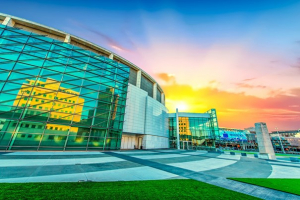Even in the midst of a pandemic, with major health and safety concerns, sustainability still matters to 58% to 67% of event professionals, according to a study published in American Express Global Meetings and Events Forecast for 2021, and they were very likely to address that issue in their meeting plans.
As we’ve seen in two previous articles (How to reduce the environmental impact of your events, Part 1 – travel and transportation, and Part 2 – energy and F&B), there are multiple ways to have a positive impact on an event’s carbon footprint. Some involve the venue you choose to host your event in.
Many venues worldwide have taken steps to ensure their operations are more sustainable. This article focuses on five convention centers in the USA that are making good on their green promises.
Colorado Convention Center, Denver, Colorado
Photo Credit: Scott Dressel-Martin for the Colorado Convention Center.
A few facts about the Center
The Colorado Convention Center provides 584,000 sq. ft. of exhibit space on one level, 63 meeting rooms providing 100,000 sq. ft. of meeting space on one level, a 35,000 sq. ft. ballroom, a 50,000 sq. ft. ballroom, and a 5,000 seat theater.
Sustainable initiatives
The Colorado Convention Center has made sustainability a priority since 2008 and encourages event planners to be a part of the effort by integrating sustainability practices into their events. The Center focuses on the following improvement areas.
Becoming more energy-efficient
To reduce energy consumption, the Colorado Convention Center has implemented mindful scheduling, equipment retrofits and upgrades, and preventative maintenance.
For example, they installed variable frequency drive fans in their HVAC system for increased efficiency and a 300kw rooftop solar array that saved, since 2008, the equivalent of 282 metric tons of carbon dioxide emissions as compared to conventionally produced electricity.
They also set their lighting level protocols at 50% for move-in and 25% for cleaning and maintenance.
Reducing waste
The Center has implemented a waste management program that identifies, reduces, and diverts the various waste streams created by venue operations, attendees, and clients. Their goal is to divert over 50% of waste from the landfill. Their initiatives include putting single-stream recycling bins next to every landfill bin and compost collection for all kitchen items, bathroom paper towels, and yard waste.
They also aim to reduce single-use plastic by providing water bottle fill stations and fully compostable service ware, as well as making bulk packaged purchases whenever possible.
Being part of the community
The Center partners with several nonprofits and local organizations to donate leftover conference materials. They also adopted 8 acres of land along the Platte River in Downtown Denver, and, each year, members of their team spend an afternoon working together to clean up and maintain the park.
Improving air quality
The Colorado Convention Center enforces a strict non-smoking policy inside the building and anywhere within 25 ft. of doors or air intakes.
Transportation options also play a big part in improving air quality, with the enforcement of an anti-idling policy, the hosting of two of Denver’s Bike Share stations on property, free parking spaces dedicated to hybrid and electric vehicles, and a free ECO-Pass provided to all full-time employees to encourage the use of light rail and bus transportation.
Saving water
The Center focuses on water quality and conservation methods, such as chemical management (bio-renewable cleaning supplies), water-efficient landscaping and irrigation (replacing the grass in certain areas with native and drought-resistant plants resulted in 75% less water being used to maintain these areas), and building infrastructure efficiency (for example, low-flow toilets and urinals).
Promoting local food
The Center partnered with Centerplate to install an urban garden with over 5,000 sq. ft. of growing space to provide the Center’s chefs with more than 1,800 pounds of fresh fruits and vegetables, as well as local honey.
Awards & certifications
In 2009, the Colorado Convention Center received an ISO 14001 certification as part of the City of Denver’s Environmental Management System.
Since 2010, the Colorado Convention Center has been LEED® (Leadership in Energy and Environmental Design) Gold Certified for Existing Building, Operation, and Maintenance.
In 2015, the Center was recognized as Gold Leader in the Environmental Leadership Program, a voluntary program administered by the Colorado Department of Public Health and Environment that recognizes organizations that go beyond compliance with environmental regulations and strive toward sustainability.
Moscone Center, San Francisco, California
Photo courtesy of Moscone Center.
A few facts about the Center
The Moscone Center (North and South) offers more than 502,000 sq. ft. of contiguous space that can be used for exhibitions and/or meetings, two ballrooms, including a 50,000 sq. ft., column-free ballroom, 82 meeting rooms, 107,000 sq. ft. of pre-function lobbies, and more than 25,000 sq. ft. of outdoor terraces. In addition, Moscone West offers 96,660 sq. ft. of dedicated main floor exhibit space and 195,848 sq. ft. of flexible swing space for meetings or exhibits.
Sustainable initiatives
The Moscone Center has been invested in sustainability since 1998 and offers meeting planners a green guide that can help them navigate the Center’s requirements.
Becoming more energy-efficient
The Center has completed a two-part energy efficiency program. The solar component consists of a solar electrical system capable of producing enough power for 550 homes annually. This is accompanied by an extensive lighting system retrofit and related energy efficiency measures designed to reduce energy usage (by as much as 20% in the first year) without diminishing interior lighting levels: all 5,000 bulbs in five exhibit halls were replaced with compact fluorescent lamps, T8 fluorescents, metal halide fixtures, all more energy efficient.
When Moscone expanded to more than two million sq. ft. in 2003 with the opening of Moscone West, they incorporated important resource-efficient design features in the new facility. These features include high-performance glazing with low emissivity glass, use of the latest and most energy-efficient lighting fixtures throughout the facility, as well as the use of daylight sensors to control pre-function areas, energy-efficient mechanical systems, including chilled water plant and cooling towers, heating water plant, and air control systems.
Reducing waste
The Moscone Center started diverting material from the waste stream in 1998. Nearly 2 million pounds is diverted annually.
The opening of Moscone West required the tracking and reporting of all waste generated during the demolition of existing buildings and the construction of the new facility. In each instance, over 80% diversion was achieved.
The Center uses an exclusive catering company whose food composting program captures all organic material from foodservice operations. They have implemented a kitchen-based composting program, use exclusively compostable foodservice ware products, and collect compost from all public areas of Moscone West.
Being part of the community
Almost 20% of all diverted material is donated to local area nonprofits. In addition, the catering company also donates unused or excess food to local nonprofits.
Improving air quality
Their initiatives in that matter include daily monitoring of carbon monoxide, sulfur dioxide, and nitrous oxide and the use of propane additives to reduce carbon monoxide emissions.
Committing to sustainable purchasing
Policies and procedures place emphasis on sustainability in all purchasing activities. For example, contracts for major capital projects include provision for required tracking and reporting of diversion by material type for large-scale contracts such as replacement of escalators, carpeting, and lighting fixtures.
Promoting mass and/or green transportation
The Center promotes the use of transit in all public information sources and supports transit use among the facility’s workforce. The exclusive caterer only delivery van operates on biodiesel fuel.
Awards & certifications
Over the years, this dedication to improving the sustainability of its operations has earned the Moscone Center multiple awards, starting in 1999 with the WRAP Award (Waste Recycling Awards Program) awarded for outstanding achievement as a commercial recycler.
Other awards include a 2009 Environmental Achievement Award from the U.S. EPA Pacific Southwest Region 9 for distinguishing itself as a sustainable building that has helped protect the environment.
The Moscone Center also achieved a LEED® Gold certification for Existing Buildings in 2012 (first convention center on the West Coast to achieve that certification) and received the California Resource Recovery Association (CRRA) Award in 2016 for Outstanding Practices in Venue/Event Resource Recovery.
Oregon Convention Center, Portland, Oregon
Photo courtesy of Metro.
A few facts about the Center
The Oregon Convention Center offers 255,000 sq. ft. of contiguous exhibit space, two ballrooms, Portland (34,200 sq. ft., with a 16,000-square-foot lobby), and Oregon (25,200 sq. ft.), divisible into sections, 52 meeting rooms, two VIP suites overlooking their respective exhibit halls, and a Suite offering meeting space, side offices, two boardrooms, and living room area.
Sustainable initiatives
A renovation project was completed in October 2019 and included sustainability as a central aspect. Overall, the Oregon Convention Center focuses its sustainability efforts on six main topics.
Becoming more energy-efficient
The facility has installed all LED lighting that is automatically controlled to brighten or dim depending on the amount of natural light in the space at a given time.
As part of the actual building and functionality changes for the renovation, a corridor was built as an alternative route, making it possible for event attendees to forego using the Center’s elevators while traveling across the first floor. Lighter usage of escalators and elevators means less energy usage (the energy use of a pair of escalators is equivalent to the annual average energy consumed by about three average American households).
Recent energy reduction projects include the implementation of energy-efficient air handlers (with variable frequency drive fan motors), interior lighting fixture upgrades, and the installation of over 6,500 solar panels now producing more than 25% of the Center’s electricity.
Reducing waste
During the renovation, a particular focus was placed on recycling construction waste, including metals and gypsum. 110 tons of carpet were removed, recycled, and repurposed. The carpet padding was remade into new carpet padding, while the carpet itself was shipped to Seattle to be made into a filtration system.
The long-term goal is to reach at least an 80% waste diversion rate, which can only be achieved through extensive waste recycling, composting, and food and reusable material donation programs, working in partnership with many local nonprofit and community assistance organizations.
All in all, the Center managed to recycle more than 400 tons of materials, divert 122 tons of food scraps from the landfill by composting, and divert 66% of all materials from the landfill.
Being part of the community
The programs developed by the Center transferred 61,580 pounds of reusable goods to nonprofit organizations and 44,240 meals to nonprofits working to address food scarcity in the Portland area.
Improving air quality
The Center has implemented an environmentally-friendly cleaning policy, in addition to integrated pest management and a no-idling policy on the loading docks.
Saving water
The Oregon Convention Center uses a mix of stormwater management and water conservation methods. These include creating a rain garden that filters particulates out of the rainwater, encouraging guests to use water bottle filling stations, upgrading all bathroom fixtures for water efficiency, etc. They estimate that these initiatives contribute to saving 1,221,180 gallons of water annually.
Committing to sustainable purchasing
The Oregon Convention Center has chosen to opt for small and local when it comes to purchasing whenever possible.
Awards & certifications
The Oregon Convention Center was the first convention center to receive the U.S. Green Building Council’s LEED® certification for Existing Buildings in 2004. In 2008, the facility was recertified at the Silver level, and they have been LEED® Platinum-certified since 2014 (the highest certification that can be achieved).
The Center has also earned a level 4 APEX/ASTM certification, the first standards created specifically for green meetings and events, and verified by the Events Industry Council.
San Diego Convention Center, San Diego, California
Photo courtesy of San Diego Convention Center.
A few facts about the Center
The San Diego Convention Center offers over 2.6 million total sq. ft. of space, including an exhibit hall providing more than 500,000 sq. ft. of contiguous exhibit space divisible into seven separate halls, up to 72 meeting rooms located throughout the upper and mezzanine levels, offering 204,000 sq. ft. of meeting space, two 40,000 sq. ft. ballrooms, and a 90,000 sq. ft. of column-free, glass-enclosed Pavilion.
Sustainable initiatives
The San Diego Convention Center is focusing its environmental efforts on three main areas.
Becoming more energy-efficient
The entire facility uses LED light fixtures, which has helped lower electricity usage. They have also added low-flow automatic sinks and toilets, drip irrigation for outdoor landscaping, and energy-efficient dishwashers.
Reducing waste
Their program includes the use of 4-stream waste receptacles divided into paper, recyclables, trash, and compost. This system lets attendees help with the recycling process. Instead of having in-sink garbage disposal units in their in-house kitchens, they compost and train staff to place all excess food scraps into compost bins. Composting also comes from the food waste sorted into the compost bin on their 4-stream containers.
Being part of the community
The Center works with event organizers to ensure that extra promotional items or event supplies do not go to waste by donating them to local organizations.
Through a partnership with Habitat for Humanity, excess booth materials from exhibitions are picked up and repurposed for building homes. They also partner with the San Diego Rescue Mission to provide unserved food to San Diegans in need (more than 100,000 meals every year).
Awards & certifications
In recognition of their efforts, SDCC was awarded a LEED® Gold certification in 2017.
TCF Center, Detroit, Michigan
Photo courtesy of TCF Center.
A few facts about the Center
TCF Center offers 723,000 sq. ft. of exhibit space and 255,000 sq. ft. of meeting space, including banquet rooms and 100 meeting rooms with seating capacities from 100 to 1,725. The dividable ballroom is 40,000 sq. ft. with floor-to-ceiling views of the Detroit Riverfront. A 24,000 sq. ft. outdoor space is also available to host exhibits and outdoor events.
Sustainable initiatives
The green efforts of the TCF Center are focused on three main areas, and they produce guidelines for event planners and exhibitors to help them navigate the Center’s green requirements and policies.
Becoming more energy-efficient
The glass-enclosed concourse area on the main level, the three-story glass atrium, and the third-floor corridor glass ceiling provide enough natural light during daytime hours to minimize main hallway daytime lighting throughout the Center. In addition, all exhibit halls are equipped with induction lighting that uses 50% less electricity.
The Center is air-conditioned by pumping grey water from the Detroit River through chillers that then send the cool water to various air handlers, providing cooling to zoned areas in the Center. This system uses considerably less electricity than conventional air conditioning units.
All main hall lighting and heat/cool settings are computer programmed and managed.
Escalators in the building are energy efficient and run based on occupancy and event needs.
The recent facility upgrade incorporates numerous green building components, including low-flow restroom and kitchen equipment, energy-efficient HVAC equipment, and a living green roof.
Reducing waste
Paper, aluminum cans, and plastic bottle recycling containers are placed in all office areas and high-traffic meeting areas throughout the Center. In addition, all in-house contractors participate in center recycling and green initiatives.
All pallets are recycled to a local area vendor and the TCF Center partners with My Green Michigan for complete composting services.
Being part of the community
Materials left by events are donated to local agencies for reuse and upcycling.
The TCF Center’s exclusive food and beverage provider collects prepared food that has not been served for pick up by a local company that delivers to pantries, soup kitchens, and shelters throughout Southeastern Michigan.
Awards & certifications
TCF Center achieved a LEED® Gold certification and is an APEX/ASTM Standard Certified Facility.
The Center has also earned many community-based awards for their sustainability leadership over the years: 2020 USGBC Leadership Award, EcoWorks Sustainable Communities Champion Award, Keep Michigan Beautiful President’s Plaque, Detroit Free Press Green Leader Award, Detroit Green Task Force Earth Day Business Award, and USGBC Detroit Region Outstanding Sustainable Design Award.
IN CONCLUSION
For event venues, the way to becoming more eco-friendly can involve alterations to the building itself with the installation of green roofs or solar panels, rainwater harvesting, low-flow bathroom features, LED lighting, smart irrigation, etc.
Venues can also make improvements on a smaller scale, such as providing soap dispensers instead of individual plastic bottles, implementing recycling and composting programs, setting up partnerships with charities to donate leftovers, growing food on-site, etc.
Most of the venues that are serious about becoming greener usually get involved in certification processes. Certifications, while not compulsory, can provide external reassurance to event planners that sustainable practices are in place.

